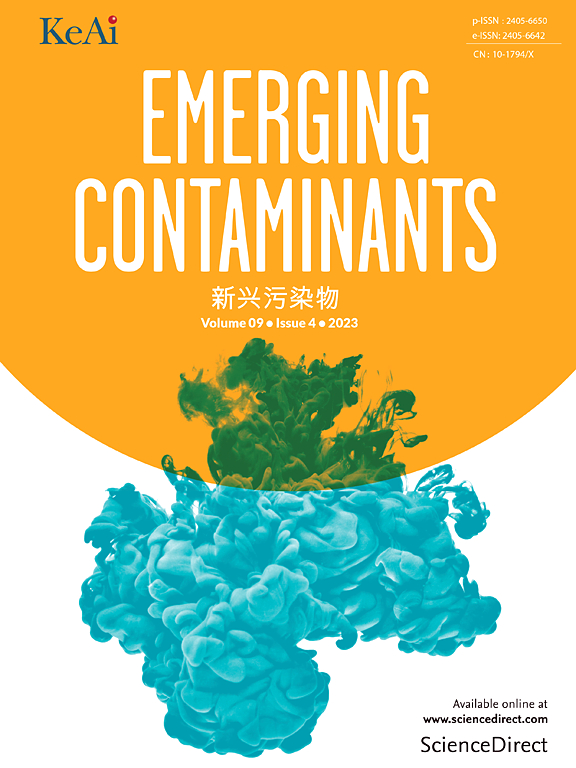Spatiotemporal distribution and environmental risk assessment of 6PPDQ in the Schuylkill River
IF 6.9
2区 环境科学与生态学
Q1 ENVIRONMENTAL SCIENCES
引用次数: 0
Abstract
Tire wear particles (TWPs) and associated contaminants, including microplastics, benzothiazoles, polycyclic aromatic hydrocarbons (PAHs), N-(1,3-dimethylbutyl)-N′-phenyl-p-phenylenediamine (6PPD), its byproduct 6PPD-Quinone (6PPDQ), and heavy metals, are emerging pollutants in aquatic ecosystems. 6PPD, a commonly used tire antioxidant, reacts with ozone to form 6PPDQ, a toxic compound linked to acute mortality in aquatic species, such as Coho salmon. Despite its known impact, data on 6PPDQ in northeastern U.S. freshwater systems, including the Schuylkill River, remain limited. This study examined the spatiotemporal distribution of 6PPDQ in the Schuylkill River and assessed its environmental risks. It also identified key contamination sources and seasonal trends. We analyzed 6PPDQ concentrations at 16 locations across different seasons using the EPA 1634 Draft Method. Their relationship with traffic volume, population density, and tire-related industrial proximity was evaluated. Concentrations ranged from non-detectable to 17.95ng/L, with urban regions exhibiting higher levels. A moderate positive correlation (r=0.416) between 6PPDQ concentrations and Average Annual Daily Traffic (AADT) suggests traffic as a significant source. Population density and industrial proximity also contributed to contamination. Based on the EPA freshwater screening value (11ng/L), two sites posed high risks, while 88% were at medium risk. Risk levels peaked in October, when increased precipitation and reduced flow exacerbated contamination. These findings highlight the seasonal intensification of 6PPDQ pollution, emphasizing the need for stormwater management and long-term monitoring to mitigate risks and assess seasonal dynamics in freshwater systems.
斯库尔基尔河6PPDQ时空分布及环境风险评价
轮胎磨损颗粒(twp)及其相关污染物,包括微塑料、苯并噻唑、多环芳烃(PAHs)、N-(1,3-二甲基丁基)-N ' -苯基-对苯二胺(6PPD)及其副产物6PPD-醌(6PPDQ)和重金属,是水生生态系统中新兴的污染物。6PPD是一种常用的轮胎抗氧化剂,与臭氧反应形成6PPDQ,这是一种有毒化合物,与Coho鲑鱼等水生物种的急性死亡有关。尽管已知其影响,但美国东北部淡水系统(包括斯库尔基尔河)的6PPDQ数据仍然有限。研究了斯库尔基尔河6PPDQ的时空分布特征,并对其环境风险进行了评估。它还确定了主要污染源和季节性趋势。我们使用EPA 1634草案法分析了不同季节16个地点的6PPDQ浓度。评估了它们与交通量、人口密度和与轮胎相关的工业邻近度的关系。浓度从无法检测到17.95纳克/升不等,城市地区的浓度更高。6PPDQ浓度与AADT呈中等正相关(r=0.416),表明交通流量是其重要来源。人口密度和工业邻近也是造成污染的原因之一。根据EPA淡水筛选值(11ng/L), 2个站点为高风险,88%为中等风险。风险水平在10月份达到峰值,当时降水增加和流量减少加剧了污染。这些发现强调了6PPDQ污染的季节性加剧,强调了雨水管理和长期监测的必要性,以减轻风险并评估淡水系统的季节性动态。
本文章由计算机程序翻译,如有差异,请以英文原文为准。
求助全文
约1分钟内获得全文
求助全文
来源期刊

Emerging Contaminants
Medicine-Public Health, Environmental and Occupational Health
CiteScore
10.00
自引率
6.70%
发文量
35
审稿时长
44 days
期刊介绍:
Emerging Contaminants is an outlet for world-leading research addressing problems associated with environmental contamination caused by emerging contaminants and their solutions. Emerging contaminants are defined as chemicals that are not currently (or have been only recently) regulated and about which there exist concerns regarding their impact on human or ecological health. Examples of emerging contaminants include disinfection by-products, pharmaceutical and personal care products, persistent organic chemicals, and mercury etc. as well as their degradation products. We encourage papers addressing science that facilitates greater understanding of the nature, extent, and impacts of the presence of emerging contaminants in the environment; technology that exploits original principles to reduce and control their environmental presence; as well as the development, implementation and efficacy of national and international policies to protect human health and the environment from emerging contaminants.
 求助内容:
求助内容: 应助结果提醒方式:
应助结果提醒方式:


